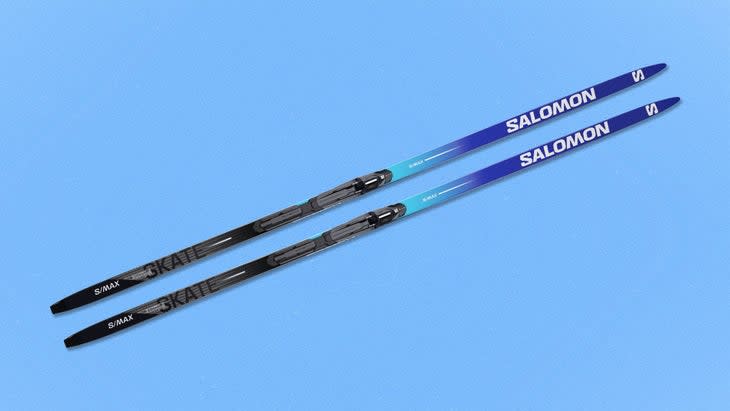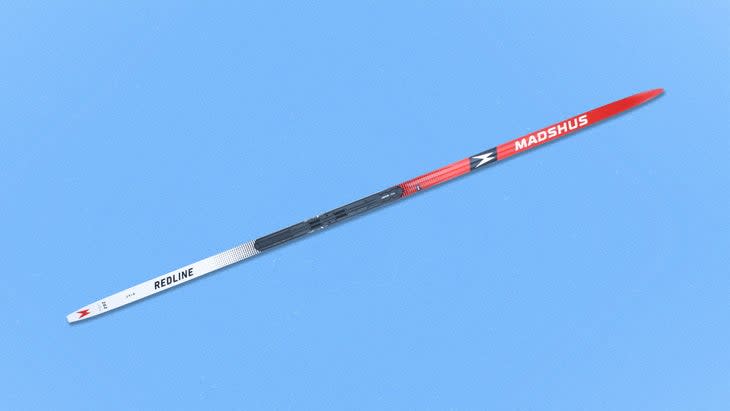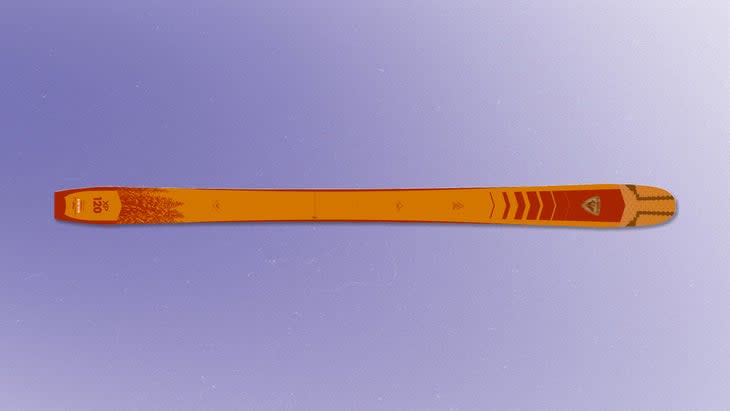The Best Cross-Country Skis
This article originally appeared on Outside
Cross-country skiing is evolving at warp speed. Skis are faster, lighter, and more durable each season. And with the advent of spray-on waxing and ever-improving skin technologies, they also require less maintenance to achieve the perfect glide. The end result is a sport that is more fun, thrilling, and user friendly than it's ever been.
Looking to round out your kit with boots, poles, or new outerwear? Check out those reviews here.
How We Tested
March and early April 2022 was a period of forever winter in northern Minnesota. The extended snow season combined with frenetic climate-change swings gave our Duluth-based testers bonus time on skis in conditions ranging from fast, cold, and freshly groomed to sun-baked slush.
To test 20 classic and skate models from recreational to World Cup race-level, we gathered ten male and female skiers, ranging from 24 to 62 years old. Some were weekend warriors and others were elite marathon racers. For the group component of our testing, we joined forces on two Saturdays in March--one that started out at negative nine degrees and another that reached a high of nearly 50 degrees. We used the Lester-Amity Ski Trails, which has 15-kilometers of groomed terrain with roughly 1,000 feet of climbing. Everyone skied in groups of two to six, swapping skis every one to eight kilometers, to ensure testing on similar snow conditions.
Simultaneously, four core testers put the same skis through extended paces over the course of five weeks, while skiing individually on trails throughout the Midwest in temperatures that ranged from -15 to 50 degrees, skiing on average between 5 and 25 kilometers per session.
After every test we asked each skier to give us oral and written feedback in multiple categories, including stiffness, flex, structure, and stability; gliding, downhill, and curving behavior; temperature range and type of snow it worked best in; and overall performance. Our final tally was surprisingly unanimous in all ski genres.
We had a few mishaps along the way. A pole got stuck so badly in a three-foot-deep snowbank that it took 15 minutes to dislodge. One of us broke a binding performing an out-of-control hockey stop on sheer ice. But by the end of the testing period, we'd narrowed down an overwhelming field of entries into the top skis, boots, poles, and accessories for cross-country skiing. See the results below.
Tester Stats
Number of testers: 10
Combined number of American Birkebeiner finishes: 96
Warmest temp: 48
Coldest temp: -15
Number of products tested: 20 skis, 10 poles, 20 boots
Number of kilometers: 965 Kilometers
Number of vertical feet: 40,000
Read more about how to get into cross-country skiing.
Meet The Testers
Stephanie Pearson
Stephanie Pearson grew up in Duluth, Minnesota, nordic skiing out her backyard. For the 2022 cross-country gear testing Pearson gathered a crew Nordic skiers who have cumulatively spent thousands of hours skiing.
Jen Pearson
Jen is a physician and associate professor in the Department of Family Medicine and BioBehavioral Health University of Minnesota. She's finished the Birkie more than 20 times, with multiple top 20 finishes.
Deb Deluca
Deb is the Executive Director of Duluth Seaway Port Authority and a former member of the US National Cycling team. She has completed 17 Birkies and has been on skis since she was four years old.
Patti Harvieux
Patti Harvieux is a coach for Duluth East Nordic Ski Team, and 18-time Birkie finisher with multiple top 20 finishes, a founder of Duluth XC Ski Club, and former director of KidSki for seven years.
Doug Hoffman
Doug is an MD who specializes in muskuloskeletal ultrasound. He has finished somewhere between 15 and 25 Birkies. At some point you lose count.
Jena Ogston
Jena is a professor at the College of St. Scholastica in Duluth, with a PhD in Rehabilitation Science. Formerly she was a physical therapist for US nordic ski team. She's also a 13-time US Birkie finisher, and one-time Norwegian Birkie finisher.
Samuel Hayden
Samuel was the captain of 2014 Duluth East High School Nordic Ski Team, which won a second-place team finish at the Minnesota State High School Championship. He was also a collegiate mountain bike racer for Fort Lewis College in Durango, Colorado. He's pursuing a doctorate in physical therapy at the College of St. Scholastica, and is the Enduro Coach for the Duluth Devo Mountain Bike Team.
Brian Hayden
Brian is the founder of the Duluth Devo Mountain Bike Program. He's also a former collegiate nordic ski racer, former ski wax technician for the Duluth East High School Nordic Ski Team, and former coach of Duluth Cross Country (DXC) Kidski Program. He's finished the Birkie twice.
Janine Sieja
Janine is a former Outside editor, two-time Birkie finisher, bike racer, and ultra runner who has competed in the Leadville 100, 24 Hours of Moab, Ice Age Trail 50, and Grandma's Marathon, among many other races.
Laurie Anderson
Laurie is a psychology Instructor at the College of St. Scholastica and a private pilot. She has completed 13 Birkies and 25 total ski marathons.
Catherine Long
Catherine is an ultra-running guide for Adventure Running Company, and six-time Birkie finisher. Her coldest ski day ever was -40 degrees at the Giant's Ridge, Minnesota “Chicks on Sticks" clinic in 2014. Her warmest ever race was +40-degrees at Snowflake Nordic Center in Duluth.
The Best Cross-Country Skis: Skate
Fischer Speedmax Helium Skate Plus ($900)

Dimensions: 41-44-44
Weight: 950 grams (186 cm)
Our testing crew had widely varying opinions on skis. But everyone unanimously agreed that when it comes to stability combined with speed, the new ultralightweight Helium Skate Plus wins. The lightest skate ski Fischer has ever produced is stable enough to cut through crud like a Ginsu knife, but is still wicked fast on hardpack--ideal for racing in variable conditions. The key is a so-called air core: a carbon-fiber matrix that looks like corrugated cardboard and runs perpendicular to the core, side-to-side across the inside of the ski, making it far lighter than traditional construction. That's wrapped in a stiffer, high-modulus carbon interlaced with fiberglass, which adds strength. The result: A fast, light, stiff ski that makes for more efficient power transfer while maintaining beautiful flex for softer snow.
For the base, Fischer used a process called cold-base bonding, which retains the integrity of the ski base's original molecular structure by avoiding heat and pressure when it's added to the ski. The technique allows for better wax absorption which, in turn, reduces friction, maximizes glide, and increases speed. In an industry first, designers extended the base material up the sidewalls. Translation: the sidewall is waxable, which boosts speed even more. "They were light, stable, and very responsive," said Jen Pearson "They skied well in both cold and warm conditions. When compared with other skis they seemed better balanced, easy to control, and effortless to use."
Bottom line: This subtle, elegant ski is for elite racers with good technique who want to land on the podium.
Salomon SMax Carbon Skate with +Shift (In Binding $670)

Dimensions: 44-43-44
Weight: 1,400 grams (192 cm with bindings)
A step below Salomon's premium World Cup-level S/Lab line, the new SMax Carbon Skate ski won huge props from testers for its light, stable feel largely derived from a new core made of recycled material. The core of this 1,400 gram skate ski is a blend of durable Densolite foam and recycled polyethylene terephthalate (PET) derived from the equivalent of nine plastic bottles (on a 201 centimeter ski), which comprises 45 percent of the core's weight.
Our testers were especially pleased with the ski's liveliness. It's not designed to make it to a World Cup podium like the Helium is, but its playfulness, combined with impressive stability compared to other skis in its class, translated to more fun on the skate deck. "The camber seemed to bounce a bit more than the other skis in this class we tested," reported Patti Harvieux. But still, "it was a very stable ski. It tracked well on the downhills," said another tester. And In a sport that's changing quickly as the result of climate change, it's nice to ski on sticks using recycled materials. Another added bonus: They come pre-coated with universal fluoro-free Swix wax. Skiers simply need to scrape and glide.
Bottom Line: This ski is for a beginner to intermediate level racer who wants to build confidence and technique before dropping more dough on a World-Cup level setup.
The Best Cross-Country Skis: Classic
Madshus Redline Classic Skin ($800)

Dimensions: 43-44-44
Weight: 900 grams (187 cm)
Testers loved this classic ski for two reasons: it performed well in a wide range of temperatures and felt fast and powerful with little slippage. This is no coincidence. Madshus overhauled this World-Cup level ski by combining two skis into one. Designers took the material layup of the brand's Redline Classic Cold and melded it with the high camber height of their Redline Classic Warm ski. The Redline Classic Cold has a foam core surrounded by interlocking strands of fiberglass and carbon fiber, making it fast, strong and exceptionally lightweight. The Warm ski has a higher camber to accommodate gooey Klister, a wax used in the warmest snow conditions. (Klister produces exceptional grip--but can cause drag on a low-camber ski with a lot of snow contact). The new Redline Classic Skin maintains the Cold's core and the Warm's shape, but replaces the wax pocket with a 100 percent mohair skin. The result: a grab-and-go no-brainer for a wider variety of conditions.
Madshus then mounted the ski with a Move 3.0 Rottefella binding (plate included, binding sold separately for $200) which takes a mere turn of a knob to reposition your body--and thus your weight-- forward or backward to suit the conditions. You can do this without clicking out of the binding, a boon for many skiers who haven't had that luxury in the past.. "At first, the Madshus was difficult for me to kick," said Harvieux after taking it out on a balmy 30-degree day. "But after moving the binding farther forward, I was able to dial in the perfect kick. That was the first time I’d had that trail convenience and really appreciated how easy it was to make this change."
The binding is key, but the real sell on this ski was that it never had a bad day despite the wildly erratic temps we skied on it, which ranged from -15 to almost 50 degrees. These stuck well with very little backsliding no matter what the weather brought on any given day.
Bottom Line: The ski is ideal for an intermediate to elite racer who can't stand waxing skis. Because it handles so well in a variety of snow conditions it's also suitable for skiers who can't afford or don't want a warm and cold-weather classic ski.
Rossignol XP 120 Positrack ($480)

Dimensions: 120/90/110
Weight: 1,600 grams
Most skis neatly fit under the cross-country, alpine, or backcountry genres, but Rossignol's new 120 Positrack is a little of all of them. With steel-edges, a low-resting camber, a wide profile, and an alpine mounting plate suitable for an AT, telemark, or Nordic backcountry binding, this lightweight fiberglass ski can be anything you want it to be. It's a little wider than similar cross-country touring skis on the market, and has a waxless base that offers enough fish-scale-like friction to kick and glide across rolling terrain without needing skins (there's also a notch for skins at the tip for steeper terrain). In the Midwest, we found these to be an excellent option when Nordic tracks or skate decks weren't groomed, or on days we simply wanted to explore our backyards. We mean that literally: One tester skied out her back door and onto the Superior Hiking Trail for miles.
Bottom Line: The ideal ski for someone who spends most of their time skiing off of groomed trails, in deeper snow, or on steeper terrain where nordic and tele-style skiing merge.
How to Buy Cross-Country Skis
Cross-country skiing can be an intimidating sport, but today's skis are more user friendly than they've ever been. The first step in buying skis is to determine what style you want to pursue: classic, skate, or backcountry.
Classic skis, most often used in a groomed cross-country ski track, are longer than skate skis and require a stride in which skis are pushed forward in a parallel motion. All of them come with a base that provides friction and thus grip: fish scales, skins, or a smooth base on which to put sticky kick wax. Waxable classic skis are generally for elite racers who want the fastest possible option. Most beginners prefer the ease and low maintenance of fish scales, which are carved into the base. Similarly, skin skis have a patch of synthetic hair--like an alpine touring skin--placed underfoot, which replaces the need for kick wax and makes the ski much more low maintenance. Over the past decade skin technology has evolved to the point that many competitive skiers train on this type of ski, or even use them on race day.
Read more about how to buy cross-country skis.
Skate skis are used on groomed skate deck and are shorter than their classic counterparts by 10-15 centimeters. Skiers propel them forward using a powerful v-shaped stride. Shorter skis are easier to handle for beginners, but longer skis give better glide. Two other specs to note: flex and structure. A more flexible ski is a more forgiving ski, which is generally better in soft snow and for skiers learning technique. A more rigid or structured ski is better on hard-pack and for power transfer, but can also be more difficult for a new skier to drive.
Backcountry cross-country skis are for those who want to get off the groomed track. These skis generally have steel edges that make carving turns on downhills easier, a sculpted waist, and a rockered tip for easy turning. Most are equipped to handle a touring, AT, or telemark binding, depending on how you want to use the ski.
For exclusive access to all of our fitness, gear, adventure, and travel stories, plus discounts on trips, events, and gear, sign up for Outside+ today.

